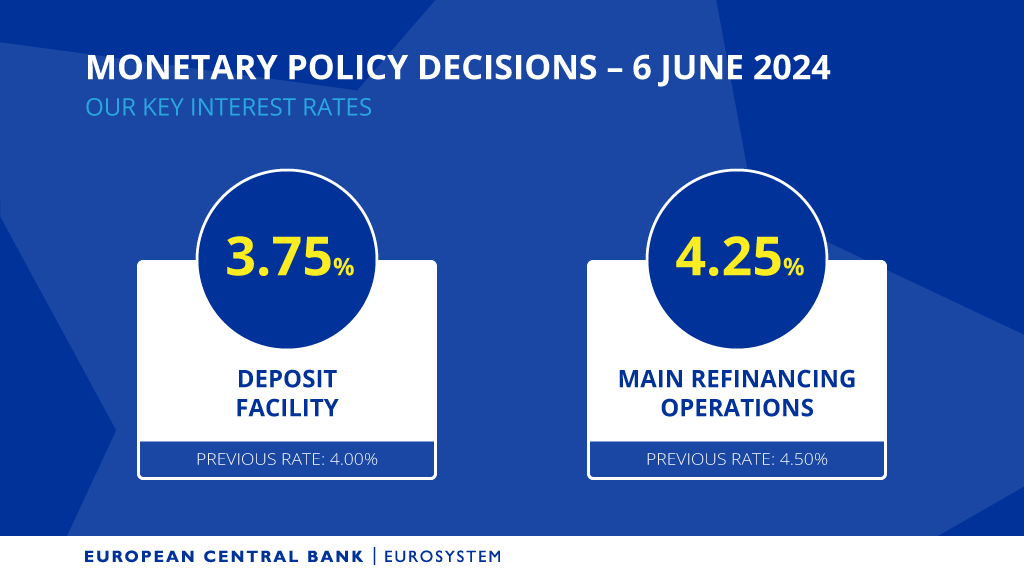Na svém čtvrtečním zasedání Rada guvernérů Evropské centrální banky (ECB) rozhodla o snížení hlavní úrokové sazby o čtvrt procentního bodu na 4,25 %. Se snižováním úrokových sazeb začala dříve než Federální rezervní systém (Fed). Toto snížení bylo očekáváno, neboť inflace v eurozóně se postupně přibližuje k cílové hodnotě 2 %, která je shodná s cílovou inflací Fedu i České národní banky.

Toto snížení úrokových sazeb je prvním od roku 2019 a přichází v době, kdy inflace v eurozóně klesá a ekonomický růst je mírně revidován směrem nahoru. Prezidentka ECB Christine Lagarde ujistila, že díky probíhající restriktivní měnové politice očekává střednědobé ustálení inflace u cílových 2 %. Letošní celková inflace je očekávána průměrně 2,5 %, v příštím roce se sníží na 2,2 % a v roce 2026 je očekávaná ve výši 1,9 %, tedy pod cílovou 2% úrovní. Jádrová inflace je letos očekávána 2,8 %, v letech 2025 a 2026 by měla být přesně na 2% úrovni.
Tento krok má za cíl podpořit ekonomický růst v zemích eurozóny, snížit inflační tlaky a posílit konkurenceschopnost evropských podniků. Očekává se, že ekonomický růst by se měl pomalu zotavovat, v letošním roce se očekává zvýšení na 0,9 %, v roce 2025 na 1,4 % a v roce 2026 na 1,6 %. K tomu podpoří poptávku po úvěrech včetně hypotečních úvěrů, což by mělo stimulovat investice, spotřebu a poptávku po nemovitostech.
Během tiskové konference Ch. Lagarde opakovala, že ECB bude i nadále pečlivě monitorovat tvrdá data a je připravena upravit své nástroje s cílem dosáhnout inflace na úrovni 2 %. Toto prohlášení není překvapivé, neboť práce s tvrdými daty je hlavní pro většinu centrálních bank včetně Fedu i ČNB a znamená, že proces snižování úrokových sazeb může být v případě potřeby zastaven.
Zasedání Fedu proběhne 11. – 12. června a je velmi nepravděpodobné, že dojde ke snížení úrokových sazeb. Bankovní rada České národní banky se sejde 27. června a zde lze očekávat snížení úrokových sazeb, avšak není jisté, zda dojde k opakovanému snížení o 50 bazických bodů či pouze o 25 bazických bodů.
…….
The European Central Bank has surpassed the Federal Reserve
The European Central Bank’s Governing Council reduced its primary interest rate by 0.25%, bringing it down to 4.25%. This move was initiated before the Federal Reserve. It was anticipated due to the euro area’s inflation gradually nearing the 2% objective, aligning with the inflation targets of both the Fed and the Czech National Bank.

The recent interest rate cut marks the first one since 2019, coinciding with a decline in inflation and a slight upward revision in economic growth within the euro area. ECB President Christine Lagarde expressed confidence in the stability of inflation at the targeted 2% over the medium term, thanks to the ongoing implementation of a restrictive monetary policy. Forecasts indicate that headline inflation will average 2.5% this year, followed by a decrease to 2.2% next year, and a further decline to 1.9% in 2026, which falls below the 2% target. Core inflation is expected to reach 2.8% this year and precisely 2% in both 2025 and 2026.
The intention behind this action is to bolster economic growth in euro-area countries, mitigate inflationary pressures, and enhance the competitiveness of European firms. Economic growth is forecasted to pick up gradually, reaching 0.9% this year, 1.4% in 2025, and 1.6% in 2026. As a result, there will be a rise in the demand for credit, particularly in mortgage lending, which is expected to fuel investment, consumption, and the real estate sector.
During the press conference, Ch. Lagarde restated the ECB’s dedication to closely monitoring hard data and being prepared to adapt its tools to achieve a 2% inflation target. This position aligns with the practices of major central banks, such as the Fed and the CBN, which rely on hard data analysis and may pause interest rate cuts when deemed necessary.
The Federal Reserve is scheduled on June 11-12, and the probability of a reduction in interest rates is quite low. Conversely, the CNB Board is set to meet on June 27, where a decrease in interest rates is anticipated, although the extent of the cut, whether it will be 50 basis points or 25 basis points, has become uncertain.




